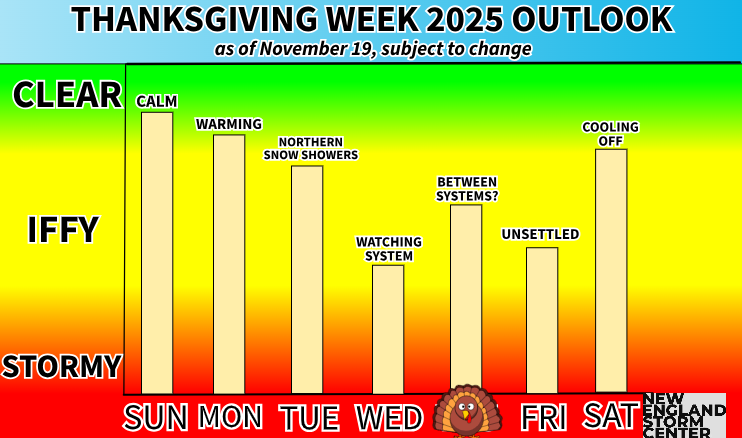High Pressure Continues to Dominate for New England
- Tim Dennis
- Sep 16
- 3 min read
Surface high pressure will be located directly over New England today, bringing another tranquil day. Highs will be right around seasonable levels as well, though a bit warmer for northern New England as they'll be closer to a strong ridge over eastern Canada. With high pressure comes a weak flow, so an onshore will develop, keeping the coast a notch cooler than the rest. Overall, 70s will continue to dominate across New England today.
Below: Pressure and flow this afternoon:

Tuesday's high pressure system will slide to the east and weaken as an area of low pressure continues to creep up the east coast. While the high will weaken and shift, it will still exert its influence over the region, especially for northern New England. This ridge, and the dry air associated with it, will do its best to keep unsettled weather from the low pressure system at bay.
As always with these sorts of slow-moving systems to the south, the question is how far north can showers push into the region. The farther south in New England you go, the higher the chance of seeing anything. At this point, however, even southernmost New England is looking at no more than a couple tenths of an inch of rainfall, so widespread precipitation anywhere remains unlikely.

An onshore flow around this system (along with the high pressure centered farther east) may bring more clouds and cooler temperatures for all areas near the coast as well. On the temperature side, Wednesday will likely end up a notch cooler for southern New England as the passing low pressure brings clouds and an onshore flow. Northern New England, remaining under the influence of high pressure, will see a mild day on Wednesday with more sun, especially away from the coastal plain.
Below: Temperature departure from average on Wednesday afternoon:

A trough will slide across southern Canada later Thursday into Friday. This will drag a cold front across New England. Return flow from the south will develop ahead of the front (as per usual), bringing a bout of warmer weather region-wide. Thursday will be a milder day for everyone across the region. The cold front itself will likely zip through New England during the day Friday.

It will take some time for the cooler air to reach the surface after the frontal passage, so southern and central New England will likely be warmer on Friday as well. The passage will likely occur very early in the day for northernmost New England, allowing for a much cooler day. Highs across the north country look to top out in the 60s while mid 70s to low 80s are likely for everyone else, but, again, the cooler air mass will be working southward through the day.
Below: Temperature departure from average Friday afternoon:

The moisture-rich southern stream storm track will remain well south of New England, so low pressure formation or increased moisture along this frontal boundary is not expected. With that said, it will likely be a mainly dry passage. With the instability of a changing air mass, there will be a chance for spotty showers as it crosses, but nothing worth writing home about. In fact, there may be increased fire weather concerns with a dry frontal passage, dry fuels and some wind from the front.
By Saturday, the cold front will have cleared New England and the entire region will be under a cooler air mass. High pressure will build in behind the front, bringing dry weather with a very autumn feel in the air. Highs in the 60s will likely dominate across the entire region. The high pressure building in will originate from the Arctic, bringing these much cooler temperatures. With high pressure overhead comes chilly overnight temperatures. Should the center of the high cross directly over New England Saturday night, a widespread frost is possible (with some freezes possible across northernmost New England).

Looking ahead, another warm-up is looking possible for next week after this upcoming weekend's cool-down. We won't go as far to call it a "second summer", but the start of astronomical fall is currently looking rather mild. This would come as a trough-in-the-west-ridge-in-the-east pattern develops. The one issue with this would be the presence of a negative NAO, which would make it more difficult for a ridge to develop. With that said, there's plenty of uncertainty in just how mild it could get.




Comments